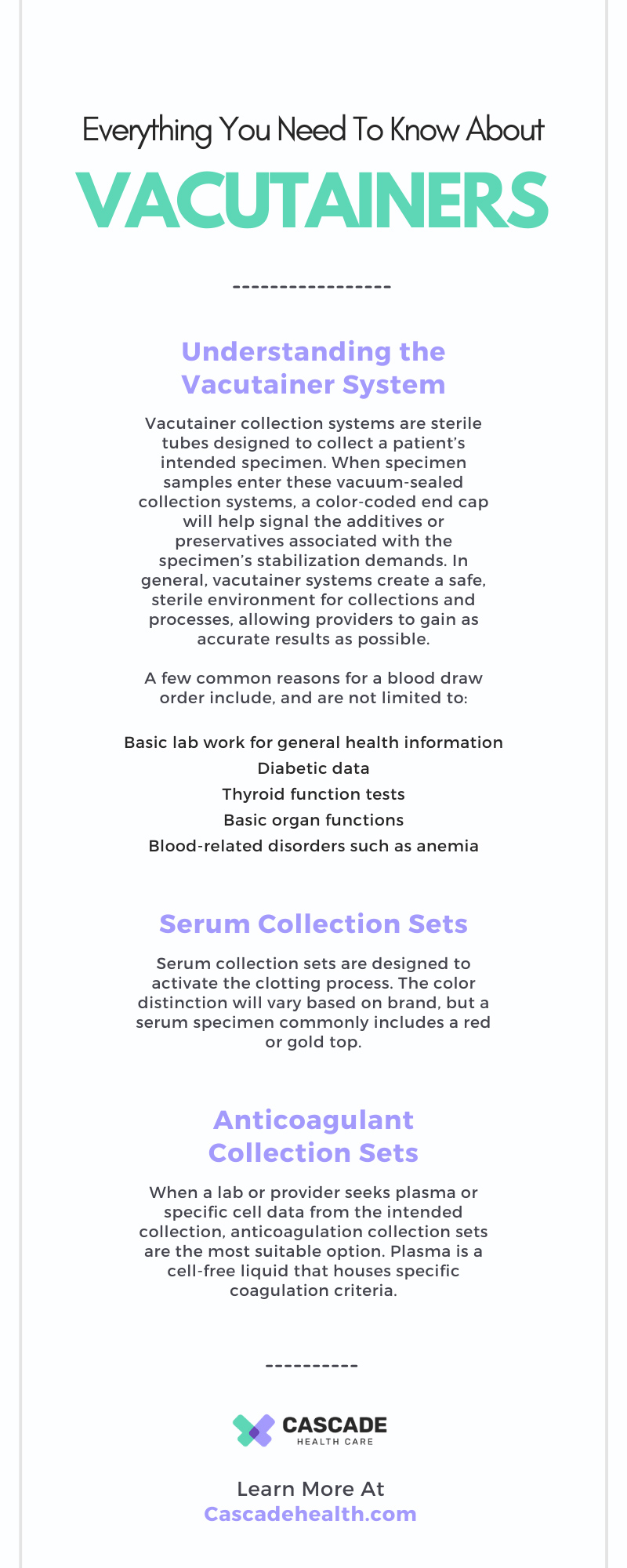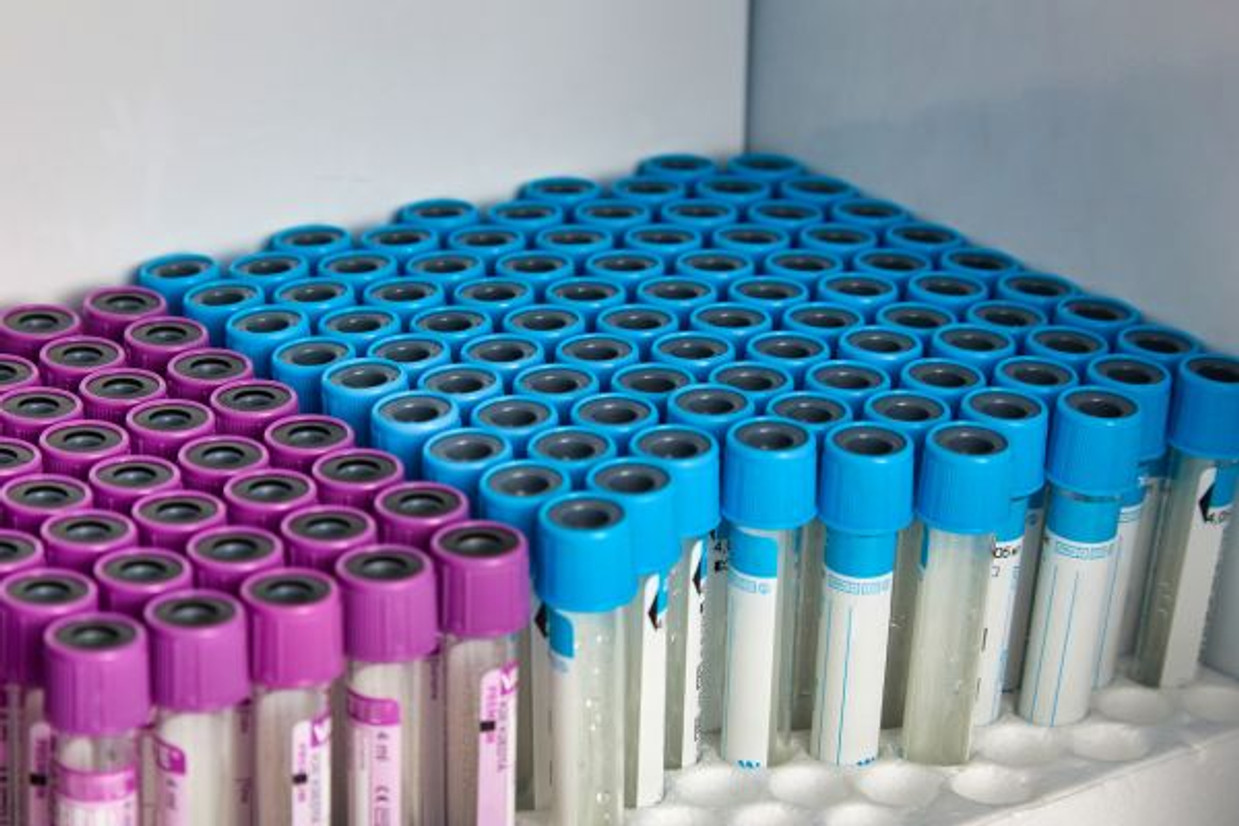Everything You Need To Know About Vacutainers
Labs everywhere rely on their ability to collect blood specimens accurately and safely from patients. Whether an individual is inpatient or requires outpatient lab work, every facility carries a complete inventory of vacutainers and butterfly needles. Here, we explore everything you need to know about vacutainers and offer insight into the types available with a few distinct properties.
Understanding the Vacutainer System
Vacutainer collection systems are sterile tubes designed to collect a patient’s intended specimen. When specimen samples enter these vacuum-sealed collection systems, a color-coded end cap will help signal the additives or preservatives associated with the specimen’s stabilization demands.
The care provider ordering a collection will communicate which sample type will get collected. This will help the corresponding lab understand which additives, if any, are necessary for these samples. A care provider will close the tube to seal the specimen inside, and this cap color will indicate the additive.
In general, vacutainer systems create a safe, sterile environment for collections and processes, allowing providers to gain as accurate results as possible. While sometimes there are lab errors, it’s essential to note that vacutainers reduce the number of manual errors and create ease when testing the collected specimen. Most often, vacutainers are for blood draws, but urinalysis sets are available that function similarly.
A few common reasons for a blood draw order include, and are not limited to:
- Basic lab work for general health information
- Diabetic data
- Thyroid function tests
- Basic organ functions
- Blood-related disorders such as anemia
The Different Types of Collection Tubes
Various collection tubes are available for labs, and each will ensure accurate draws and timely results. It’s vital for a lab to carry a wide selection of vacutainer types to offer optimized patient care. We discuss the different types below and highlight the intent behind each color code.
Serum Collection Sets
Serum collection sets differ from plasma collection sets and are designed to activate the clotting process. The color distinction will vary based on brand, but a serum specimen commonly includes a red or gold top.
Each serum collection set will contain a silica interior which aids in the blood’s ability to clot. Some tubes and silica components will separate the serum, but if the tube does not contain a separation gel, the serum collection will most likely serve as basic diagnostic testing. The serum collection set is best for labs seeking blood protein data without coagulation factors.
Anticoagulant Collection Sets
When a lab or provider seeks plasma or specific cell data from the intended collection, anticoagulation collection sets are the most suitable option. Plasma is a cell-free liquid that houses specific coagulation criteria. We explore the varieties of anticoagulation collection sets below that are commonly found and used in labs.
Purple – EDTA
The purple vacutainer collection system is a relatively common set that labs use for most basic draws. The purple color code signifies EDTA-treated samples, which stand for Ethylenediaminetetraacetic acid. The distinct function of EDTA helps prevent calcium chelating in the specimen, which is a primary coagulation factor. Most tubes will house a K2EDTA or a K3EDTA component. These collection tubes are often seen in basic hematology for blood cell counting, typing, or identifying.
Light Blue 1 – CTAD
CTAD is not as common as other vacutainer systems, but worth knowing about because they do exist in most labs for specific specimen samples. Citrate, theophylline, adenosine, and dipyridamole make up CTAD collections and prevent the stimulation of platelet ex vivo. These are incredibly light-sensitive, so storing CTAD sets in a cool, dry, dark location is vital.
Light Blue 2 – Sodium Citrate
Sodium citrate is a calcium-removal collection set. But the removal process is reversible, and a lab may add calcium back into the specimen if necessary. The primary function of a sodium citrate collection is measuring the coagulation factors within the plasma. If calcium needs to get returned to the sample, it’s best to use controlled conditions for these factors.
If a sodium citrate sample is necessary, it should not be the first collection post-venipuncture. Instead, the phlebotomist should use a discarded tube before drawing a sodium citrate sample. Each brand that sells light blue sodium citrate tubes will feature variable citrate concentrations, so it’s vital to understand which concentration you require and which type you’re purchasing.
Green – Sodium Heparin or Lithium
A heparin tube is similar to a simple serum collection set, but the heparin gel performs a separation technique for a plasma-specific specimen. The sodium heparin activator will inhibit the formation of thrombin, which is a clotting enzyme in plasma. Heparin can and will interfere with a PCR-intended collection and may cause a reaction.
Yellow 1 – Acid Citrate Dextrose
The yellow acid citrate dextrose collection is also not a commonly used vacutainer set, though it is found in labs depending on the intentions behind orders. The acid citrate dextrose most often serves the DNA analysis test and can also work in blood and tissue type samples.
Yellow 2 – Sodium Polyanethol Sulfonate
The second yellow option a microbiology lab or research study will use is sodium polyanethol sulfonate. While uncommon in medical labs, it is worth noting that this collection set helps stabilize the bacteria growth in a specimen.
Black or Grey – Sodium Fluoride
Depending on the brand, the sodium fluoride collection set may be black or grey. Sodium fluoride acts as an antiglycolytic agent, which serves a glucose test best. Another common test ordered for sodium fluoride is the lactate test. Each tube will house an anticoagulant, but the type will vary based on brand and availability.
At Cascade Health Care, we offer everything you need to know about vacutainers and their characteristics so your lab or facility can make informed decisions about which sets will serve you best. Accompany your collection systems by shopping our butterfly needles for sale and ensuring your samples are safe for providers and patients. If you have questions or concerns regarding how to use the needle sets with your collection systems, partner with a member of our team today. We look forward to serving your facility.

Recent Posts
-
Positions for Out-of-Bed Laboring During a Home Birth
For midwives, doulas, and other healthcare professionals who attend home births, facilitating a safe
-
5 Applications for Dopplers in Endocrinology
Doppler ultrasound technology has transformed diagnostic capabilities across multiple medical specia



